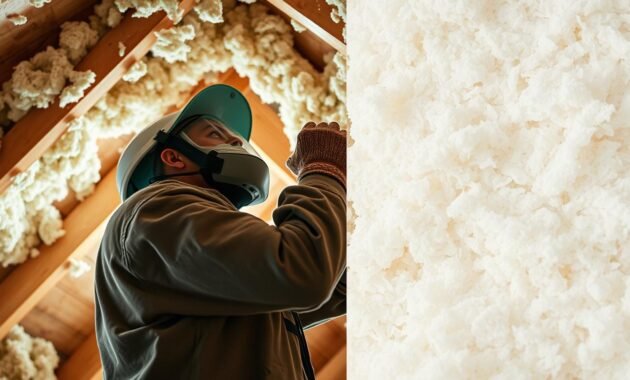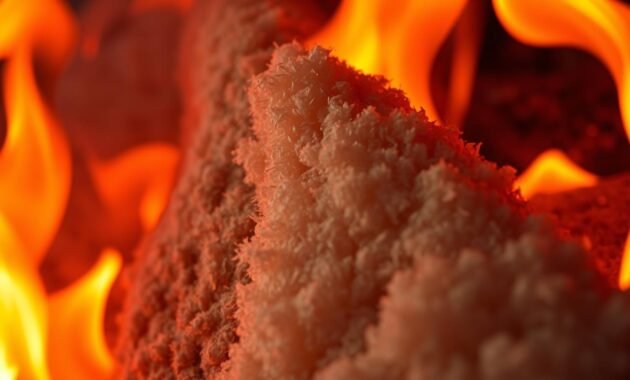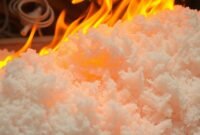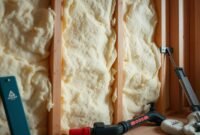As a homeowner, I know how key insulation is for comfort and saving energy. In attic insulation, fiberglass and cellulose blown insulation are top choices. But which one is better? This guide aims to answer that question.
Insulation keeps my home warm and saves on heating and cooling bills. The U.S. Department of Energy says the right insulation can cut these costs by up to 15%. They also suggest an R-value of R-30 to R-60 for attics in most areas for the best efficiency.
Fiberglass and cellulose blown insulation each have their own pros and cons. The best option for me will depend on my budget, climate, and preferences. In this article, I’ll look into each insulation type, compare their performance, and help me choose wisely for my home and wallet.

Key Takeaways
- Insulation is key for home comfort and saving energy, cutting heating and cooling costs by up to 15%.
- The Department of Energy suggests an R-value of R-30 to R-60 for attics in most climates.
- Cellulose insulation is made of about 85% recycled materials, while fiberglass has 20-30% recycled content.
- Cellulose insulation has a higher R-value per inch, providing better thermal performance.
- Fiberglass insulation is generally cheaper than cellulose, in both material and installation costs.
Understanding Home Insulation Basics
Insulation is key to a cozy and energy-saving home. The R-value measures how well insulation blocks heat. The higher the R-value, the better it keeps your home warm or cool.
Good insulation stops heat from leaving in winter and entering in summer. This keeps your home’s temperature steady. It makes your home comfy and cuts down on energy bills. The material used also affects how well it works, with some being more efficient than others.
What is R-Value and Why It Matters
The R-value shows how well insulation blocks heat. The higher it is, the better it keeps your home comfortable. It helps keep your home warm in winter and cool in summer, saving on heating and cooling costs.
The Role of Proper Insulation in Energy Efficiency
Good insulation is vital for saving energy at home. It stops heat from moving, so you don’t need to use as much energy to stay comfortable. This saves money on bills and is better for the planet.
Types of Blown Insulation Materials
There are many types of blown insulation, like cellulose and fiberglass. Cellulose is made from recycled paper and is blown in with special equipment. Fiberglass is made of tiny glass fibers and is also blown into walls and attics.
Cellulose Insulation: Overview and Composition
Cellulose insulation is a green and flexible option for home insulation. It’s made from up to 85% recycled paper, like newspaper. It’s treated with fire retardants and borates to fight pests and boost its fire safety.
Read also: Does Fiberglass Insulation Burn?
This insulation has a high R-value, from 3.2 to 3.8 per inch. This is better than fiberglass, making it great for tight spaces. It also blocks sound well, making homes quieter.
Cellulose insulation fits into odd shapes and spaces well. This ensures full coverage and less air leaks. It’s often used in attics, walls, and hard-to-reach spots.
But, it might soak up moisture and settle over time. This could lower its effectiveness. Proper installation and care are key to keeping it working well.
| Cellulose Insulation Composition | Key Features |
|---|---|
85% recycled paper products Treated with fire retardants and borates |
|
Fiberglass Insulation: Materials and Manufacturing
Fiberglass insulation is a popular choice for homes in the U.S. It’s made from tiny glass fibers. These fibers come from a mix of recycled glass and sand.
The top fiberglass insulation makers use 20-30% recycled content. This makes it a green option for homes.
Glass Fiber Production Process
The glass fiber production starts with melting raw materials like sand and limestone. This molten mix is then pushed through small holes in a device called a bushing. This creates long, thin glass fibers.
These fibers cool down, get a binder coating, and are shaped into batts or loose-fill material.
Recycled Content in Modern Fiberglass
Fiberglass insulation stands out because it includes recycled content. Using a lot of recycled glass reduces its environmental impact. It’s a sustainable choice for homeowners.
This recycled content also helps save natural resources and keeps waste out of landfills.
Forms of Fiberglass Insulation
Fiberglass insulation comes in different forms for various uses. The two main types are:
- Fiberglass batts: These are flexible panels for fitting between wall studs and ceiling joists.
- Loose-fill fiberglass: This is a fluffy material for filling attics, walls, and other hard spots.
Read also: How to Remove Insulation From Attic
Both forms have a good R-value, usually between R-2.2 and R-2.7 per inch. They are also moisture-resistant and last long. This makes them a favorite for improving home energy efficiency and comfort.
Fiberglass vs Cellulose Blown Insulation: Performance Comparison
Both fiberglass and cellulose blown insulation have their own strengths. Cellulose often beats fiberglass in thermal performance. It has a higher R-value per inch, which means it can reach the recommended R-38 value with less insulation.
Cellulose needs about 7 inches to get to R-38, while fiberglass takes around 10 inches. This makes cellulose a better choice for insulation.
But, it’s key to remember that adding more insulation after R-40 doesn’t help much in most areas. Both fiberglass and cellulose can be great when installed right. They help your home stay energy-efficient and warm.
| Insulation Type | R-Value per Inch | Inches Required for R-38 | Thermal Performance |
|---|---|---|---|
| Cellulose Blown Insulation | 3.5 – 4.0 | ~7 inches | Higher |
| Fiberglass Blown Insulation | 2.5 – 3.8 | ~10 inches | Lower |
The choice between fiberglass and cellulose depends on your climate, budget, and what you prefer. Both can make your home more energy-efficient and comfortable. It’s all about finding the right fit for your needs.

Cost Analysis and Long-term Value
Insulation costs can change a lot based on the material, how it’s installed, and where you live. Fiberglass is often cheaper, but the price difference with cellulose can vary. It’s key to think about the long-term benefits each offers.
Initial Installation Expenses
Fiberglass insulation is usually cheaper to put in. It costs $0.85-$1.25 per square foot for batts and $1.25-$1.75 for blown-in. Cellulose insulation costs $1.35-$1.85 per square foot for blown-in.
Maintenance Requirements
Both fiberglass and cellulose need little upkeep. But, cellulose might need topping up sometimes because it settles. Fiberglass keeps its insulating power for a long time.
Energy Savings Over Time
The true value of insulation is in saving energy and cutting down on bills. Fiberglass and cellulose have similar R-values. But, cellulose might seal air better and block noise. Saving energy with either can lower your monthly bills a lot.
Choosing between fiberglass and cellulose depends on your needs, budget, and home goals. Think about the upfront costs, upkeep, and energy savings. This will help you pick the best option for your home’s long-term value.
Installation Methods and Best Practices
Proper installation of blown-in insulation is essential for its effectiveness. Whether using cellulose or fiberglass, the process needs specialized tools and skills. Attic preparation, setting up the machine, and adjusting the spread for even coverage are key steps.
While DIY might seem appealing, it’s not recommended for blown-in insulation. Professionals have the right equipment and skills for a thorough job. DIY attempts can cause uneven coverage, gaps, and lower insulation performance. This can lead to higher energy costs and future problems.
- Prepare the attic by removing old insulation and debris, and sealing air leaks or cracks.
- Set up the blowing machine and adjust the settings for the right flow and distribution of insulation.
- Monitor the installation closely, adjusting the spread as needed for even insulation.
- Focus on hard-to-reach areas and ensure complete coverage, including around obstacles and in tight spaces.
- Properly install rafter dams to prevent insulation from spilling into unintended areas and maintain the recommended R-value.
Read aslo: Blown-In Insulation VS Spray Foam
Working with a professional insulation installer ensures the job is done correctly the first time. This maximizes the benefits of blown-in insulation and boosts your home’s energy efficiency.
| Insulation Type | R-Value Range | Typical Installation Time | DIY Suitability |
|---|---|---|---|
| Fiberglass Loose Fill | R-11 to R-30 | 2-4 hours | Moderate |
| Cellulose Loose Fill | R-13 to R-20 | 4 hours | Low |
Moisture Resistance and Durability Factors
Home insulation needs to handle moisture well and last a long time. Fiberglass and cellulose blown insulation differ in these areas. Knowing these differences helps homeowners choose wisely.
Fiberglass insulation is better at fighting moisture than cellulose. It doesn’t soak up water like cellulose does. But, fiberglass can grow mold if it stays wet for too long. So, keeping moisture away and ensuring good attic ventilation is key.
Cellulose insulation can take in some moisture but dries out when the wetness goes away. This is good in some cases. Yet, it shows the need for good moisture management.
- Fiberglass insulation is more resistant to moisture, but can support mold growth if exposed to persistent dampness.
- Cellulose insulation can absorb some moisture but can dry out without losing insulating power if the moisture source is addressed.
- Proper attic ventilation and moisture control are critical for both types to avoid mold and mildew.
The insulation’s lifespan is also important. Fiberglass lasts longer than cellulose because it doesn’t break down or settle. This makes fiberglass a more durable choice for homes, improving their value and energy use.
| Characteristic | Fiberglass Insulation | Cellulose Insulation |
|---|---|---|
| Moisture Resistance | More resistant, but can support mold growth with persistent dampness | Can absorb some moisture, but can dry out without losing insulating power |
| Lifespan | Longer lifespan, up to 50 years | Shorter lifespan, up to 30 years |
| Mold Prevention | Requires proper moisture control and attic ventilation | Requires proper moisture control and attic ventilation |
In summary, both fiberglass and cellulose blown insulation have their own strengths and weaknesses. Homeowners should think about these, along with other factors like cost and performance. This helps choose the best insulation for their homes, ensuring energy efficiency and good air quality for years to come.
Fire Safety and Chemical Treatments
Insulation safety is key, and both cellulose and fiberglass have their own needs. Fire retardants are vital for these materials to resist fire and meet building codes. Cellulose, made from recycled newspaper, gets treated with borates. This not only fights fire but also keeps pests away.
Fiberglass, being non-combustible, doesn’t need extra chemical treatments. Research shows it and mineral wool keep their fire-resistant qualities without needing fire-retardant chemicals.
But, cellulose, despite its fire treatments, is seen as a fire risk by the Consumer Product Safety Commission. Spray foam, which ignites at 700°F, also raises fire safety concerns.
Fiberglass and mineral wool are safe, with no cancer risks, according to health groups. But, cellulose lacks thorough safety tests, raising health questions. Spray foam’s safety, including health risks, is also being looked into.
| Insulation Type | Fire Resistance | Health and Safety Concerns |
|---|---|---|
| Fiberglass | Inherently non-combustible, no additional fire-retardant treatments required | Extensively tested and not considered carcinogenic |
| Cellulose | Treated with fire-retardant chemicals, but stil recognized as a potential fire hazard | Lacks extensive toxicological testing, safety concerns remain |
| Spray Foam | Ignites at 700°F, raising fire safety concerns | Safety, including potential health risks, is stil under evaluation |
In summary, both cellulose and fiberglass aim to fight fire, but their inherent qualities and treatments are key to safety. Homeowners should weigh these factors when picking insulation for their homes.

Health Considerations and Safety Measures
Insulation safety is key. Both fiberglass and cellulose blown insulation can be risky if not installed right. Knowing the risks and taking steps to avoid them is important for a safe insulation job.
Fiberglass can irritate skin and cause breathing problems if glass fibers are inhaled. Cellulose dust is also dangerous if it’s in the air during installation. To stay safe, always wear protective gear like respirators and coveralls.
After insulation is installed correctly, it’s safe for people to be around. But, it’s vital to make sure insulation doesn’t leak into living areas. This keeps the air clean and healthy.
- Wear respirators and protective clothing during insulation installation to avoid skin and respiratory irritation.
- Maintain good air quality by properly sealing and containing the insulation material.
- Regularly inspect the insulation for any deterioration or damage that could lead to the release of particles.
- Consider alternative insulation materials, such as rockwool or foam board, if you have concerns about the safety of fiberglass or cellulose.
| Insulation Type | Health Risks | Safety Measures |
|---|---|---|
| Fiberglass | Skin irritation, respiratory issues, eye irritation | Use respirators, protective clothing, and ensure proper containment |
| Cellulose | Respiratory issues from dust inhalation | Use respirators, protect against dust exposure |
| Spray Foam | Lung damage, asthma from chemical exposure | Hire professional installers, ensure proper ventilation |
Conclusion
Exploring both cellulose and fiberglass insulation, I found they both boost my home’s energy efficiency and comfort. Cellulose has a higher R-value and is eco-friendlier, but fiberglass is cheaper. My choice will depend on my budget, preferences, and home needs.
It’s important to get professional installation, no matter the choice. This ensures the insulation works well and lasts long. Whether I choose fiberglass for better thermal and sound control or cellulose for air sealing, my home will be more efficient and sustainable.
Considering factors like insulation type, energy savings, comfort, environmental impact, and installation quality, I’m ready to make a smart choice. With the right insulation, I’ll enjoy a cozy, energy-saving home that improves my life quality.


